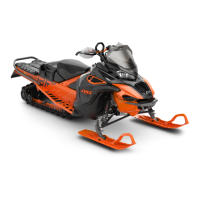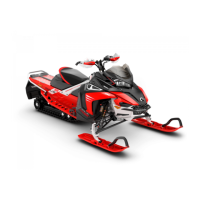RIDING THE VEHICLE
Before venturing on the trails, operate
the sn owmobile in a restricted flat area
until you are comp lete ly familiar with
its operation and feel comfortable that
you can safely tackle a more demand-
ing task . Have an enjoyable and safe
ride.
Principle of Operation
Propulsion
Depressing throttle lever increases
engine R PM causing th e drive pulley
to engage. Depending on models, en-
gine RPM must be between 2500 and
4200 before drive pulley engagement
will occur.
Outer sheave of drive pulley moves
toward inner sheave, forcing the drive
belt to move upward on the drive
pulley and simultaneously forcing the
sheaves apart on the driven pulley.
The driven pulley senses the load on
the trac k and limits the b elt move-
ment. The result is an optimized
speed ratio between engine RPM and
the speed of the vehicle at any time.
WARNING
Never operate engine without belt
guard securely installed or, with
hood or access/side panels open
or removed.
Power is transferred to the track
through the chaincas e or gearbox
and drive axle.
WARNING
Always use a wide-base snowm o-
bile mechanical stand to properly
support vehicle during any track
verification. Slowly accelerate
engine in order to rotate track at
very low speed when it is not on
ground.
Turning
Handlebar controls the steering of the
vehicle. As the handlebar is rotated to
right or left, the s kis are turned right or
left to steer the snowmobile.
Stopping
Before riding your snowmobile, you
should understand how to stop it.
This is done by releasing the throttle
and gradually depressing the brake
lever on the left side of the handlebar.
In an emergency, you may stop your
vehicle by p ressing the engine cut-out
switch located near the throttle control
and applying the brake. Remember, a
snowmobile cannot “stop on a d ime”.
Braking characteris tics vary w ith deep
snow, pack ed snow or ice. If the t ra ck
is lo cke d durin g hard brak ing, sk idd ing
may result.
How to Ride
How to Dress
Proper snowmobile clothing should
be worn. It should be com fortable
and not too tight. Always check the
weather forecast before going on a
ride. Dress for the coldest weather
expected. Thermal underwear next
to the skin also provides a good insu-
lation.
DOT approved helmets are recom-
mended at all times. They provide
both warmth and reduce injury. A
stocking type cap, balaclava and face
mask should always be carried or
worn. Goggles or a face shield that
attach to the helmet are indispens-
able.
Hands should be protected by a pair
of snowmobile gloves or mitts which
have sufficient insulation and allow
use of thumbs and fingers for opera-
tion of controls.
_____________________
13

